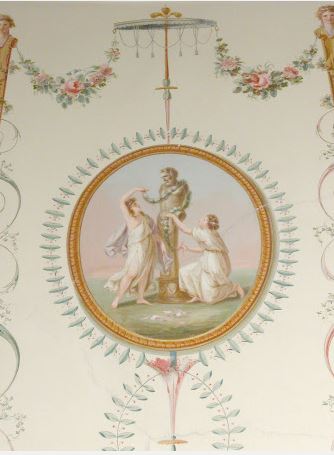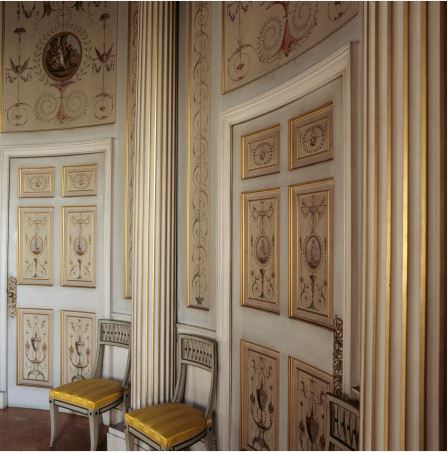This blog continues in the “Europe & the U.S. in 99 Objects” series. Dr. Gabriella de la Rosa at the National Trust has started this project for the National Trust, originally published here, by delving into the Trust’s collections – nearly 1 million objects held at over 200 historic properties across the United Kingdom – to find objects with interesting, unusual and unexpected connections to Europe. These objects and their stories are being published in the form of a digital diary on the National Trust Collections website.
#18 A Herm of Pan adorned by Nymphs (after Angelica Kauffman)
attributed to Louis-André Delabrière
Category: Art / Oil paintings
Date: circa 1785
Materials: Oil on plaster
Place of origin: England
Collection: Attingham Park, Shropshire (Accredited Museum)
On show at: Attingham Park, Shropshire, Midlands, National Trust
NT 609129
This roundel depicts two nymphs placing a garland of flowers around a pillar of Pan. It is part of a larger decorative scheme in the painted boudoir at Attingham Park.
Built between 1782-5 for Noel Hill, 1st Lord Berwick, Attingham was designed by George Steuart – a former assistant and rival of Robert Adam – who devised the symmetrical plan of matching suites of rooms of increasing intimacy on either side of the entrance hall: Lord Berwick’s wing to the left and Lady Berwick’s wing to the right. The boudoir is the last and most intimate of the rooms in the female wing of the house.
The theme of the decoration in this circular room is Love, which is not insignificant. The 1st Lord and Lady Berwick, perhaps unusually for their time and social standing, married for love. Lady Berwick was not an heiress and Lord Berwick’s family objected to the match.
This subtly painted scene is attributed to the French artist Louis-André Delabrière. His panels, along with the doors and ceiling of this room, are among the most delicate schemes of late 18th-century decoration to survive in this country. They are based, in part, on designs by the Swiss-born but Italian-trained Angelica Kauffman, who arrived in London in 1766 to social and artistic acclaim.
Over the past century, the term ‘boudoir’ has developed risqué connotations, but there was nothing lewd about this room during the 1780s when it was created. The boudoir, and Delabrière’s decorations in it, represented the pinnacle of aristocratic sophistication and feminine taste. Marie Antoinette had a similar painted boudoir at Fontainebleau, France.
#19 Fan
Category: Objets de vertu
Date: 13 Jul 1878
Materials: Cherrywood, Gilt, Glass, Velvet
Collection: Hughenden, Buckinghamshire (Accredited Museum)
On show at: Hughenden, Buckinghamshire, London and South East, National Trust
NT 428696
This cherrywood fan was presented to Benjamin Disraeli, Earl of Beaconsfield at the conclusion of the Congress of Berlin.
In June of 1878, the German Chancellor, Otto van Bismarck, drew the leaders of Europe together to discuss ways to curb Russian aggression towards the Ottoman Empire in the eastern Mediterranean.
Queen Victoria expressed her dismay at Disraeli travelling so far, but for the elder statesman, the lure of performing what might perhaps be his final diplomatic role was too strong. Despite his ailing health, Disraeli rose to this most crucial occasion, securing concession after concession from the Russians.
As the Congress drew to a close in mid-July, the international prestige of Disraeli and his British administration reached new heights. He wrote to the queen that ‘he had assisted in bringing about a settlement which will probably secure the peace of Europe for a long time’.
So delighted with the resolution, the Ottoman delegate, Mahomet Ali, presented his fan to Disraeli as a keepsake, but only after the other Congress members each signed a blade of the fan.






